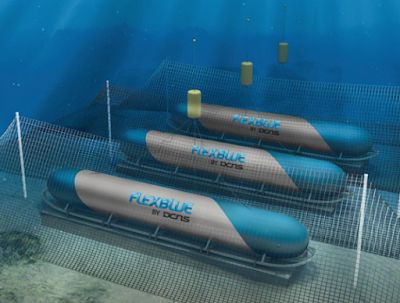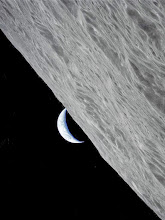 |
| FlexBlue subsea nuclear reactor being deployed by vessel (Credit: DCNS) |
by Marcel F. Williams
Within the Exclusive Economic Zones (EEZ) of remote US island territorial waters, centrally mass produced subsea commercial nuclear reactors could be safely deployed and utilized to provide all of America's energy and industrial chemical needs. In fact, remote US territorial waters alone, could provide the American continent and the rest of the world with all of the electricity, transportation fuel, industrial chemicals, and fertilizers needed to sustain human civilization.
 |
| United States Exclusive Economic Zones (Credit: NOAA) |
Anchored and moored above the seabed, approximately 100 meters below the water's surface, subsea nuclear power
plants would be safe from damage from extreme temperatures, hurricanes,
earthquakes, and tsunamis, plane crashes and ship collisions. And even
if a subsea reactor is seriously damaged, no electricity is need for the
reactor to passively shut down since it allows the natural cooling ability of
the ocean to keep its fuel from melting.
 |
| Notional FlexBlue reactor farm at the bottom of a sea bed (Credit: DCNS) |
Under
this scenario, subsea nuclear reactors, similar to the 250 MWe
FlexBlue reactors proposed by France, could be clustered in groups of
eight (2000 MWe) and under the control of a floating Control Center
barge. Up to eight such nuclear complexes (nuplexes) would be placed
along a circle four kilometers in
diameter, producing as much as 16 GW of electric power. Power plant
employees living alone would be comfortably housed at one of two cruise
ships positioned at the center of the surrounding circle of nuplexes
(nearly two kilometers away) when they're not working.
 |
| Floating Control Center connected to subsea nuclear reactors floating above the seabed. |
Five to ten kilometers distant from the nuplexes, a variety of floating barges designed to produce carbon neutral synthetic fuels, industrial chemicals, and fertilizers would be deployed to utilize the nuclear electricity provided through submarine cables. Synplex and nuplex workers and their families could be housed in cruise ships positioned at least ten to twenty kilometers away from the nuclear synplex zones.
 |
| Ocean Nuclear Zone and surrounding Synplex Zone |
The security of the nuplex zone would be provided by the US Coast Guard, under this scenario, put payed for by the private nuplex company or companies. Security for the surrounding synplex zone would be provided by private security companies paid for by the synplex companies.
So any attempt at terrorism against a subsea reactor would require terrorist to pass through a privately protected synplex zone five kilometers wide and then pass through an inner Coast Guard protected area that's an additional five kilometers wide-- areas where ships not related to the synplexes or nuplexes would be forbidden to enter. And if a subsea reactor somehow became extensively damaged, it would still be surrounded by the virtually infinite heat sink of the ocean which would make the meltdown of its nuclear fuel-- impossible.
 |
| Island EEZ with designated areas for seasteading and nuclear synplex zones |
If such nuclear synplexes were confined to a quarter of the EEZ area at least 100 kilometers away from a natural island or atoll, less than half of the nuclear synplex zone could produce more than 1.7 Terrawatts of electricity. So the synplex zones within the EEZ areas of just three different remote US island territories could, in theory, provide all of America's energy and industrial chemical needs. But such nuclear synplex zones could be deployed in the remote EZZ areas of: Wake Island, the Midway Islands, the Northern Mariana Islands, the Palmyra Atoll, the Johnston Atoll, Jarvis Island, and the Howland and Baker Islands. The vast and remote Aleutian Island chain would also be an excellent location for nuclear synplex zones.
The opposite quarter of the island's EEZ would be for a aquaculture and seasteading (inhabited artificial islands). While no one has ever been killed or even harmed from radiation from commercial nuclear power plants within the US, more than 116 million people on the continental US live within 80 kilometers of a commercial nuclear power plant. So the closest seasteaders under this scenario would be more than 200 kilometers away from ocean synplexes and nuplexes that would already be substantially safer than terrestrial commercial nuclear power plants that are already incredibly safe.
1. Methanol
2. Gasoline
3. Diesel Fuel
4. Jet fuel
5. Kerosene
6. Dimethyl ether
7. Liquid hydrogen
8. Liquid oxygen
9. Potable water
10. Sodium Chloride (salt)
11. Ammonia
12. Urea
13. Formaldehyde
14. Chlorine
15. Uranium
Synplex zones could also be used to locate floating factories that could export their manufactured goods to ports located around the world.
Methanol manufactured from Ocean Nuclear Synplexes could use methanol powered tanker ships to export methanol to coastal cities and towns around the world for the production of electricity. Greenhouse gas polluting natural gas power plants can be easily and cheaply converted to burn carbon neutral methanol. Floating methanol energy barges could be used to quickly deployed to provide electricity to coastal towns and cities around the world. Such energy barges and methanol tankers could also be transported into the Great Lakes area of the US to provide carbon neutral electricity to interior states such as Ohio, Indiana, Illinois, Michigan, Wisconsin, and Minnesota plus the Canadian province of Ontario.
And if the CO2 from the flu gasses from methanol power plants are recovered and exported back to Ocean Nuclear Synplexes for the production of even more methanol, methanol power plants would be carbon negative (extracted carbon dioxide from the atmosphere for each new plant that is either deployed or converted to use methanol).
Since sunlight only provides 8 hours a day of useful energy for solar power plants, methanol electric power plants using synthetic methanol could be used as backup power, replacing greenhouse gas polluting natural gas power plants.
In the near future, a US state like California could export its urban and rural biowaste to a remote nuclear synplex located in the EEZ area of Wake Island. Nuclear electricity could be used to convert the biowaste into syngas through plasma arc pyrolysis. The syngas would be enriched with hydrogen produced from the electrolysis of water extracted from seawater in order to triple the production of carbon neutral methanol. The methanol could then be exported to back to coastal cities and towns in California to produce back up electricity for its future solar electric power plants. The recaptured CO2 from the flu gasses from the methanol power plants could be exported back the the Wake Island EEZ for the production of more methanol. So methanol produced from nuclear electricity from the remote Wake Island EEZ could provide at least 70% of California's electric power needs while inland solar energy could provide the rest of California's electricity needs during the daylight hours when the skies are not significantly overcast. Carbon neutral methanol, gasoline, jet fuel, diesel fuel, and dimethyl ether produced from the Wake Island EEZ nuclear synplex zone could also provide California with all of its transportation fuel needs.
Links and References
Flexblue: A Subsea Reactor Project
Siting Ocean Nuclear Power Plants in Remote US Territorial Waters for the Carbon Neutral Production of Synfuels and Industrial Chemicals
Will Russia and China Dominate Ocean Nuclear Technology?FlexBlue Underwater Commercial Nuclear Reactor
The Future of Ocean Nuclear Synfuel Production
Fueling Our Nuclear Future




















No comments:
Post a Comment